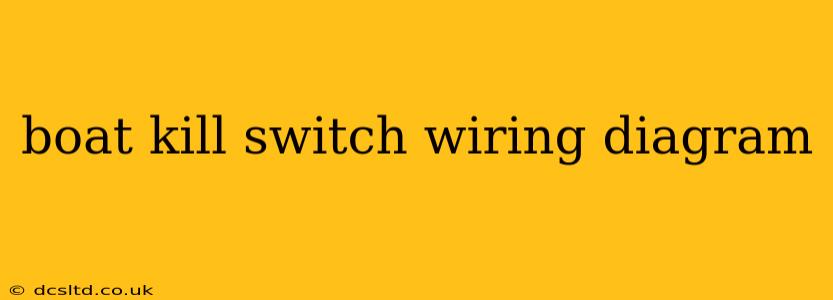Understanding your boat's kill switch wiring is crucial for safety. A properly functioning kill switch instantly cuts power to the engine in an emergency, preventing accidents and potentially saving lives. This comprehensive guide will walk you through boat kill switch wiring diagrams, troubleshooting common issues, and ensuring your safety on the water.
What is a Boat Kill Switch?
A boat kill switch, also known as an emergency stop switch or lanyard switch, is a safety device that interrupts the electrical circuit to the engine, causing it to immediately shut down. This is essential in situations where the operator is thrown overboard or loses control of the vessel. The switch is typically connected to the engine via a lanyard – a safety cord attached to the operator's person. If the operator is separated from the lanyard, the engine automatically cuts off.
Standard Boat Kill Switch Wiring Diagram
While specific wiring diagrams vary depending on the boat's make, model, and year, the basic principle remains the same. The kill switch acts as an "on/off" switch in the ignition circuit. Here's a general representation:
Simplified Diagram:
Battery (+) --> Ignition Switch --> Kill Switch --> Engine Starter Solenoid --> Engine (-)
Explanation:
- Battery (+): The positive terminal of the boat's battery provides power to the entire system.
- Ignition Switch: This switch controls the power flow to the rest of the circuit. Turning the key to the "on" position allows power to reach the kill switch.
- Kill Switch: This is the crucial component. When the lanyard is attached, the circuit remains closed, allowing power to flow. When the lanyard is disconnected, the circuit opens, cutting power to the engine.
- Engine Starter Solenoid: This solenoid acts as a relay, activating the starter motor when the ignition is turned on. The kill switch interrupts power to the solenoid, preventing the engine from starting or running.
- Engine (-): The negative terminal of the engine completes the circuit, ensuring the engine receives power.
How to Wire a Boat Kill Switch (General Steps)
Disclaimer: Wiring a boat's electrical system can be complex and potentially dangerous. If you are not comfortable working with electrical systems, consult a qualified marine mechanic. Incorrect wiring can lead to engine failure or even fire. This information is for educational purposes only and should not be considered professional advice.
The exact process will vary, but the general steps typically involve:
- Identify the wires: Locate the appropriate wires leading to the ignition switch and the engine starter solenoid. Your boat's wiring diagram (often found in the owner's manual) will help identify these.
- Connect the kill switch: The kill switch will have two terminals. Connect one to the wire coming from the ignition switch and the other to the wire going to the starter solenoid. The correct connection order is crucial – refer to your boat's wiring diagram.
- Secure the connections: Use appropriate wire connectors and crimp them securely to prevent loose connections. Marine-grade connectors are recommended for their resistance to corrosion and moisture.
- Test the kill switch: Once wired, test the kill switch thoroughly. Turn the ignition on, start the engine, and then disconnect the lanyard. The engine should immediately shut off. If not, carefully recheck the wiring.
Troubleshooting Common Boat Kill Switch Problems
H2: My kill switch isn't working. What should I do?
First, visually inspect the lanyard and the switch itself for any visible damage or signs of wear. Check the connections for corrosion or loose wires. If the problem persists, use a multimeter to check for continuity in the circuit. If you lack electrical experience, seek help from a qualified mechanic.
H2: How often should I replace my boat kill switch?
While there's no definitive timeframe, it's good practice to inspect your kill switch regularly, especially before each boating season. Replace it if you notice any wear and tear, damage, or if it's not functioning correctly. A faulty kill switch can be a significant safety hazard.
H2: Can I install a kill switch myself?
While it's possible, installing a kill switch involves working with the boat's electrical system, which can be complex and potentially dangerous if done incorrectly. If you're not experienced in electrical wiring, it's best to have a qualified marine mechanic install it.
H2: Where can I find a replacement kill switch?
Replacement kill switches are readily available at most marine supply stores, boat dealerships, and online retailers. When purchasing a replacement, ensure it's compatible with your boat's electrical system. Refer to your owner's manual or contact your boat manufacturer for specifications.
By understanding the fundamentals of your boat's kill switch wiring, you can ensure its proper function and contribute to a safer boating experience. Remember to always prioritize safety and seek professional assistance when needed.
